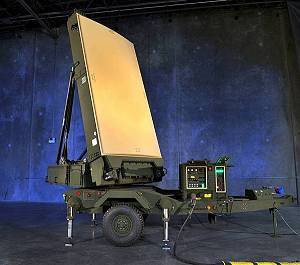
Multifunctional radar surveillance system Osprey MM
The photo was taken during the flight of the first AW101 NAWSARH helicopter. The photographs in the "windows" show the location and mounting of the antenna units of the Osprey MM radar.
In early May, the Airborne & Space Systems division of the Leonardo-Finmeccanica Spa industrial group for the first time presented its new product in London - the Osprey MMSR airborne surveillance radar system using flat antenna units with active phase arrays with AFAR.
Warmate belongs to a specific category of unmanned weapons that carry out attacks by hitting a flying projectile of the vehicle. In the English-language nomenclature, such a solution is referred to as loitering ammunition (circular ammunition), and the manufacturer calls it micro-BBSP (Unmanned Air Combat System). So far, almost all aircraft of this type of systems in the world are equipped with a piston engine with a pusher propeller. This helps to reduce the cost of these weapons compared, for example, with guided missiles. This, combined with the high accuracy of the strike, due to the ability to choose the appropriate angle and direction of attack, as well as the ability to interrupt the execution of the task already in flight, makes unmanned kamikaze an ideal weapon in the era of asymmetric warfare.
Israel Aerospace Industries (IAI) is a pioneer in the development of this type of UAV. Currently, the Israeli concern offers four types of unmanned aerial vehicles, classified as
loitering ammunition. The oldest of them is "Harpy" (currently its modernized version "Harpy NG" is offered), whose task is to disable the enemy's air defense system, therefore, "Harpy" is aimed at electromagnetic waves emitted by operating radar stations. Harpy has found many buyers around the world. At the moment, it was purchased, in particular, by India, Chile, the Republic of Korea, Turkey and the People's Republic of China. The sale of UAVs to China led to Israel's exclusion from the joint strike program in 2005.
Fighter, which proves the capabilities of this system and the technical solutions used in it. The Harpy is a vehicle with a range of 500 km and a maximum speed of 185 km/h, and its armament is a 32 kg warhead. In 2005, IAI began producing an even larger Harop camera (its airframe also uses the Harpy NG). Harop has a range of 1000 km and carries a 26 kg warhead. So far, in addition to Israel, it has been ordered by India and Azerbaijan. The last country uses Haropy in combat, even this year it was used in combat in Nagorno-Karabakh. Thanks to the optoelectronic head with a sensor system installed under the front of its fuselage, Harop can be used both to deal with various targets, including moving ones, and for reconnaissance. Harpy and Harop fire their multi-barreled launchers,
installed on trucks. In the Israel Defense Forces, such launchers are part of the artillery units, for which Harop can also conduct reconnaissance or be used to destroy targets not covered by armor or concrete, which costs less than an attack using GMLRS missiles and does not require significant collateral damage. IAI offered Poland Harops along with LORA precision surface-to-surface missiles as part of the Homar program. Harop must detect targets for LORA missiles and evaluate the consequences of fire or hit less important targets. In addition, IAI offers the latest Green Dragon and Rotem L cameras. The first is a 15kg tactical camera with a flight duration of 1,5 hours and a flight range of 40 km, taking off from containers, which can be installed on a vehicle. in a 4 × 4 system. Rotem L is a rotorcraft with a tandem transverse twin-rotor system designed for operation over urban areas. Armed with a kilogram warhead, it can operate for 30-45 minutes at a range of 1500 m (it is possible to increase the range to 10 km). Both Green Dragon and Rotem L will be controlled from portable consoles.
